Detecting Wind Farm Impacts on Local Vegetation Growth in Texas and Illinois Using MODIS Vegetation Greenness Measurements
Abstract
:1. Introduction
2. Data and Methodology
2.1. Study Region
2.2. Satellite Data
2.3. Meteorological Data
2.4. Detection and Attribution Methods
3. Results
3.1. Spatial Coupling Analysis
3.2. Time Series Analysis
3.3. Seasonal Cycle Analysis
4. Uncertainties in Detection and Attribution
5. Conclusions
Supplementary Materials
Acknowledgments
Author Contributions
Conflicts of Interest
References
- Meyers, J.; Meneveau, C. Optimal turbine spacing in fully developed wind farm boundary layers. Wind Energy 2012, 15, 305–317. [Google Scholar] [CrossRef]
- Armstrong, A.; Waldron, S.; Whitaker, J.; Ostle, N.J. Wind farm and solar park effects on plant-soil carbon cycling: Uncertain impacts of changes in ground-level microclimate. Glob. Chang. Biol. 2014, 20, 1699–1706. [Google Scholar] [CrossRef] [PubMed]
- Wind Machines. Available online: http://www.orchard-rite.com/wind-machines-for-frost-protection/crop-diversification/ (accessed on 19 May 2017).
- Rajewski, D.; Tackle, E.; Lundquist, J.; Oncley, S.; Prueger, J.; Horst, T.; Rhodes, M.; Pfeiffer, R.; Hatfield, J.; Spoth, K.; et al. Crop Wind Energy Experiment (CWEX): Observations of surface-layer, boundary layer, and mesoscale interactions with a wind farm. Bull. Am. Meteorol. Soc. 2013, 94, 655–672. [Google Scholar] [CrossRef]
- Rajewski, D.A.; Takle, E.S.; Lundquist, J.K.; Prueger, J.H.; Pfeiffer, R.L.; Hatfield, J.L.; Doorenbos, R.K. Changes in fluxes of heat, H2O, and CO2 caused by a large wind farm. Agric. For. Meteorol. 2014, 194, 175–187. [Google Scholar] [CrossRef]
- Rajewski, D.A.; Takle, E.S.; Prueger, J.H.; Doorenbos, R.K. Toward understanding the physical link between turbines and microclimate impacts from in situ measurements in a large wind farm. J. Geophys. Res. Atmos. 2016, 121, 13392–13414. [Google Scholar] [CrossRef]
- Rhodes, M.E.; Lundquist, J.K. The effect of wind-turbine wakes on summertime US midwest atmospheric wind profiles as observed with ground-based doppler lidar. Bound. Layer Meteorol. 2013, 149, 85–103. [Google Scholar] [CrossRef]
- Zhou, L.; Tian, Y.; Baidya, R.S.; Thorncroft, C.; Bosart, L.F.; Hu, Y. Impacts of wind farms on land surface temperature. Nat. Clim. Chang. 2012, 2, 539–543. [Google Scholar]
- Zhou, L.; Tian, Y.; Baidya, R.S.; Dai, Y.; Chen, H. Diurnal and seasonal variations of wind farm impacts on land surface temperature over western Texas. Clim. Dyn. 2013, 41, 307–326. [Google Scholar] [CrossRef]
- Zhou, L.; Tian, Y.; Chen, H.; Dai, Y.; Harris, R.A. Effects of topography on assessing wind farm impacts using MODIS data. Earth Interact. 2013, 17, 1–18. [Google Scholar] [CrossRef]
- Harris, R.A.; Zhou, L.; Xia, G. Satellite observations of wind farm impacts on nocturnal land surface temperature in Iowa. Remote Sens. 2014, 6, 12234–12246. [Google Scholar] [CrossRef]
- Slawsky, L.M.; Zhou, L.; Baidya, S.R.; Xia, G.; Vuille, M.; Harris, R.A. Observed thermal impacts of wind farms over northern Illinois. Remote Sens. 2015, 15, 14981–15005. [Google Scholar] [CrossRef] [PubMed]
- Xia, G.; Zhou, L.; Freedman, J.M.; Roy, S.B.; Harris, R.A.; Cervarich, M.C. A case study of effects of atmospheric boundary layer turbulence, wind speed, and stability on wind farm induced temperature changes using observations from a field campaign. Clim. Dyn. 2016, 46, 2179–2196. [Google Scholar] [CrossRef]
- Chang, R.; Zhu, R.; Guo, P. A case study of land-surface-temperature impact from large-scale deployment of wind farms in China from Guazhou. Remote Sens. 2016, 8, 790. [Google Scholar] [CrossRef]
- Roy, S.B.; Traiteur, J.J. Impacts of wind farms on surface air temperatures. Proc. Natl. Acad. Sci. USA 2010, 107, 17899–17904. [Google Scholar] [CrossRef]
- Smith, C.R.; Barthelmie, R.J.; Pryor, S.C. In situ observations of the influence of a large onshore wind farm on near-surface temperature, turbulence intensity and wind speed profiles. Environ. Res. Lett. 2013, 8, 034006. [Google Scholar] [CrossRef]
- Armstrong, A.; Burton, R.R.; Lee, S.E.; Mobbs, S.; Ostle, N.; Smith, V.; Whitaker, J. Ground-level climate at a peatland wind farm in Scotland is affected by wind turbine operation. Environ. Res. Lett. 2016, 11, 044024. [Google Scholar] [CrossRef]
- Keith, D.W.; DeCarolis, J.F.; Denkenberger, D.C.; Lenschow, D.H.; Malyshev, S.L.; Pacala, S.; Rasch, P.J. The influence of large-scale wind power on global climate. Proc. Natl. Acad. Sci. USA 2004, 101, 16115–16120. [Google Scholar] [CrossRef] [PubMed]
- Roy, S.B.; Pacala, S.W.; Walko, R.L. Can large scale wind farms affect local meteorology? J. Geophys. Res. 2004, 109, D19101. [Google Scholar]
- Roy, S.B. Simulating impacts of wind farms on local hydrometeorology. J. Wind Eng. Ind. Aerodyn. 2011, 99, 491–498. [Google Scholar] [CrossRef]
- Fitch, A.C.; Olson, J.; Lundquist, J.; Dudhia, J.; Gupta, A.; Michalakes, J.; Barstad, I. Local and mesoscale impacts of wind farms as parameterized in a mesoscale NWP model. Mon. Weather Rev. 2012, 204, 3017–3038. [Google Scholar] [CrossRef]
- Fitch, A.C.; Lundquist, J.K.; Olson, J.B. Mesoscale influences of wind farms throughout a diurnal cycle. Mon. Weather Rev. 2013, 141, 2173–2198. [Google Scholar] [CrossRef]
- Cervarich, M.; Baidya, R.S.; Zhou, L. Spatiotemporal structure of wind farm-atmospheric boundary layer interactions. Energy Procedia 2013, 40, 530–536. [Google Scholar] [CrossRef]
- Xia, G.; Cervarich, M.C.; Baidya, S.B.; Zhou, L.; Minder, J.; Freedam, J.M.; Jiménez, P.A. Simulating impacts of real-world wind farms on land surface temperature using WRF model. Part I: Validation with MODIS observations. Mon. Weather Rev. 2017. in revision. [Google Scholar]
- Wang, C.; Prinn, R.G. Potential climatic impacts and reliability of large-scale offshore wind farms. Environ. Res. Lett. 2011, 6, 025101. [Google Scholar] [CrossRef]
- McNaughton, K.G. Effects of windbreaks on turbulent transport and microclimate. Agric. Ecosyst. Environ. 1988, 22, 17–39. [Google Scholar] [CrossRef]
- Tang, B.; Wu, D.; Zhao, X.; Zhou, T.; Zhao, W.; Wei, H. The observed impacts of wind farms on local vegetation growth in northern China. Remote Sens. 2017, 9, 332. [Google Scholar] [CrossRef]
- U.S. Wind Industry First Quarter 2017 Market Report. Available online: http://awea.files.cms-plus.com/FileDownloads/pdfs/1Q2017%20AWEA%20Market%20Report%20Public%20Version.pdf (accessed on 27 April 2017).
- USDA. Crop Production 2016 Summary. Available online: http://usda.mannlib.cornell.edu/usda/current/CropProdSu/CropProdSu-01-12-2017.pdf (accessed on 7 May 2017).
- Federal Aviation Administration (FAA) Wind Turbine Location Data. Available online: https://www.fws.gov/southwest/es/Energy_Wind_FAA.html (accessed on 19 May 2017).
- Huete, A.; Didan, K.; Miura, T.; Rodriguez, E.P.; Gao, X.; Ferreira, L.G. Overview of the radiometric and biophysical performance of the MODIS vegetation indices. Remote Sens. Environ. 2002, 83, 195–213. [Google Scholar] [CrossRef]
- Bogaert, J.; Zhou, L.; Tucker, C.J.; Myneni, R.B.; Ceulemans, R. Evidence for a persistent and extensive greening trend in Eurasia inferred from satellite vegetation index data. J. Geophys. Res. Atmos. 2002, 107. [Google Scholar] [CrossRef]
- Kaufmann, R.K.; Arrigo, R.D.; Laskowski, C.; Myneni, R.B.; Zhou, L.M.; Davi, N.K. The effect of growing season and summer greenness on northern forests. Geophys. Res. Lett. 2004, 31. [Google Scholar] [CrossRef]
- Shen, M.G.; Piao, S.L.; Jeong, S.J.; Zhou, L.M.; Zeng, Z.; Ciais, P.; Chen, D.; Huang, M.; Jin, C.S.; Li, L.Z.; et al. Evaporative cooling over the Tibetan Plateau induced by vegetation growth. Proc. Natl. Acad. Sci. USA 2015, 112, 9299–9304. [Google Scholar] [CrossRef] [PubMed]
- Zhou, L.; Tucker, C.J.; Kaufmann, R.K.; Slayback, D.; Shabanov, N.Y.; Myneni, R.B. Variations in northern vegetation activity inferred from satellite data of vegetation index during 1981 to 1999. J. Geophys. Res. 2001, 106, 20069–20083. [Google Scholar] [CrossRef]
- Zhou, L.; Kaufmann, R.K.; Tian, Y.; Myneni, R.B.; Tucker, C.J. Relation between interannual variations in satellite measures of northern forest greenness and climate between 1982 and 1999. J. Geophys. Res. 2003, 108, 4004. [Google Scholar] [CrossRef]
- Zhou, L.; Tian, Y.; Myneni, R.B.; Ciais, P.; Saatchi, S.; Liu, Y.; Hwang, T. Widespread decline of Congo rainforest greenness in the past decade. Nature 2014, 509, 86–90. [Google Scholar] [CrossRef] [PubMed]
- Chen, D.; Huang, J.; Jackson, T.J. Vegetation water content estimation for corn and soybeans using spectral indices derived from MODIS near-and short-wave infrared bands. Remote Sens. Environ. 2005, 98, 225–236. [Google Scholar] [CrossRef]
- Hua, W.J.; Chen, H.S.; Zhou, L.M.; Xie, Z.H.; Qin, M.H.; Li, X.; Ma, H.D.; Huang, Q.H.; Sun, S.L. Observational quantification of climatic and human influences on vegetation greening in China. Remote Sens. 2017, 9, 425. [Google Scholar] [CrossRef]
- Matsushita, B.; Yang, W.; Chen, J.; Onda, Y.; Qiu, G. Sensitivity of the enhanced vegetation index (EVI) and normalized difference vegetation index (NDVI) to topographic effects: A case study in high-density cypress forest. Sensors 2007, 7, 2636–2651. [Google Scholar] [CrossRef]
- ASOS Network. Available online: https://mesonet.agron.iastate.edu/request/download.phtml (accessed on 19 May 2017).
- Palmer, W.C. Meteorological Drought; U.S. Department of Commerce: Washington, DC, USA, 1965.
- Dai, A.; Trenberth, K.E.; Qian, T. A global dataset of Palmer Drought Severity Index for 1870–2002: Relationship with soil moisture and effects of surface warming. J. Hydrometeorol. 2004, 5, 1117–1130. [Google Scholar] [CrossRef]
- Illston, B.G.; Basara, J.B.; Crawford, K.C. Seasonal to interannual variations of soil moisture measured in Oklahoma. Int. J. Clim. 2004, 24, 1883–1896. [Google Scholar] [CrossRef]
- Vermote, E.F.; Kotchenova, S. Atmospheric correction for the monitoring of land surfaces. J. Geophys. Res. Atmos. 2008, 113. [Google Scholar] [CrossRef]
- Miura, T.; Huete, A.R.; Yoshioka, H.; Holben, B.N. An error and sensitivity analysis of atmospheric resistant vegetation indices derived from dark target-based atmospheric correction. Remote Sens. Environ. 2001, 78, 284–298. [Google Scholar] [CrossRef]
- Vermote, E.; Saleous, E.L.; Justice, C.O. Atmospheric correction of MODIS data in the visible to middle infrared: First results. Remote Sens. Environ. 2002, 83, 97–111. [Google Scholar] [CrossRef]

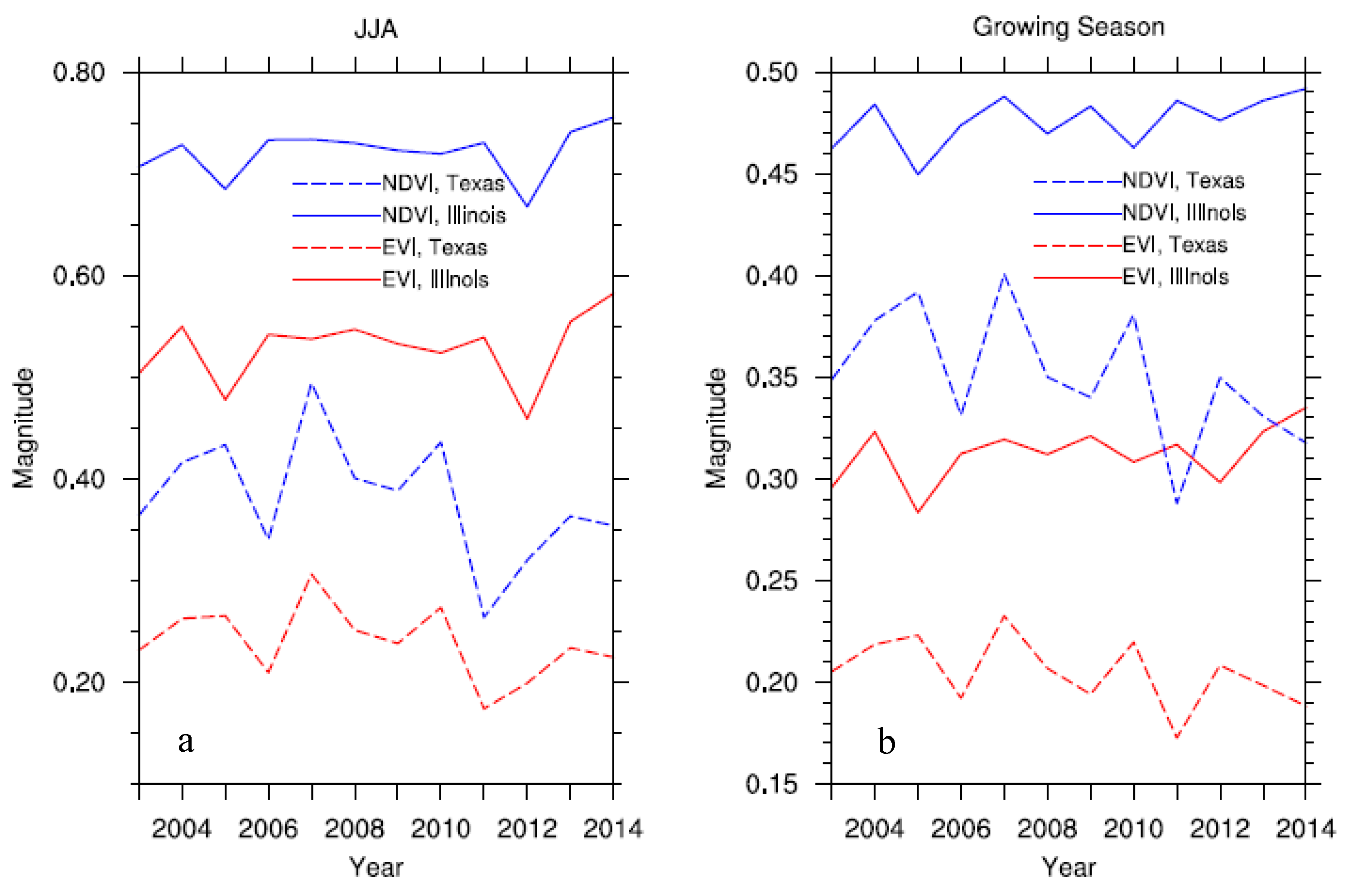
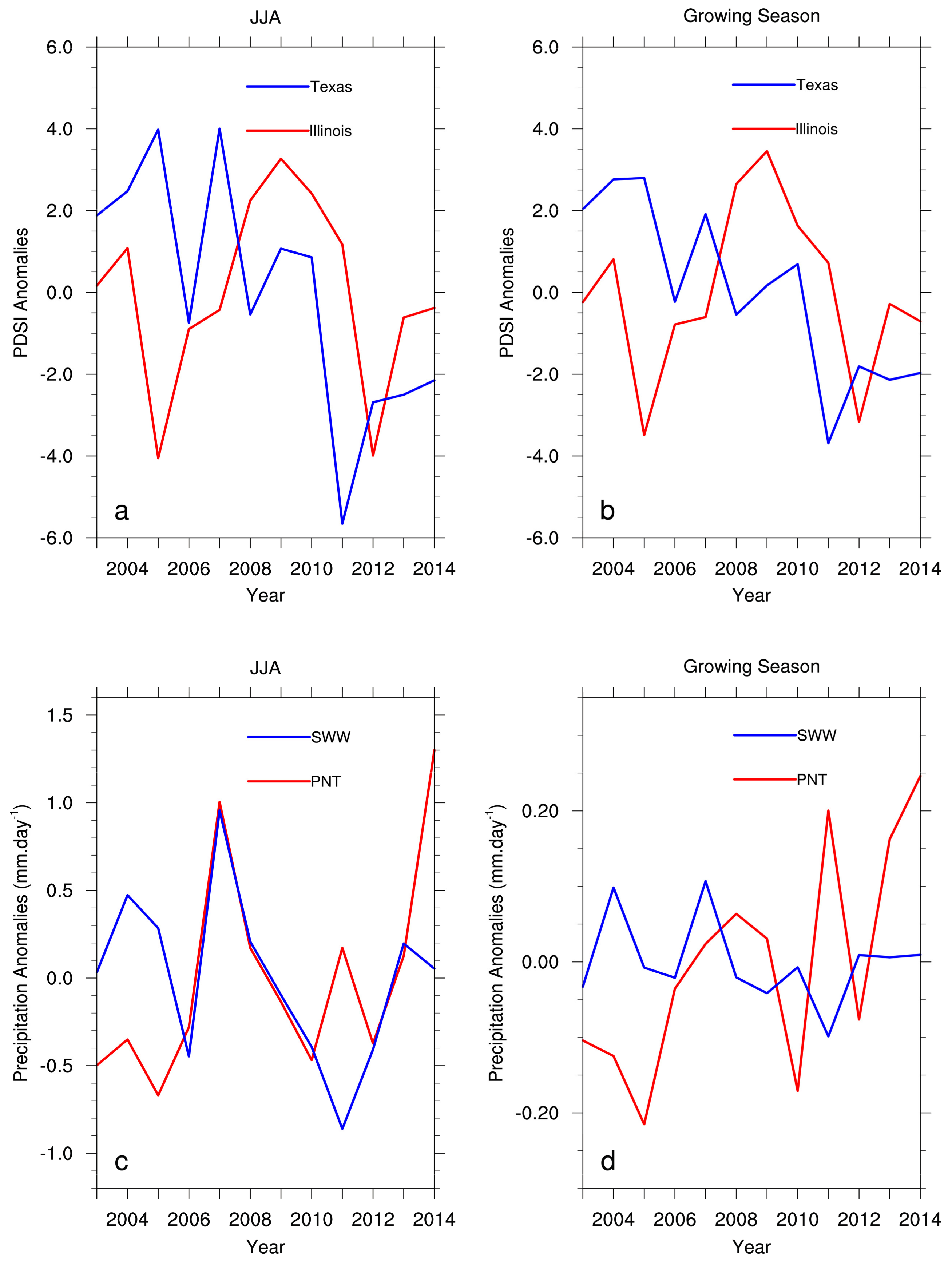
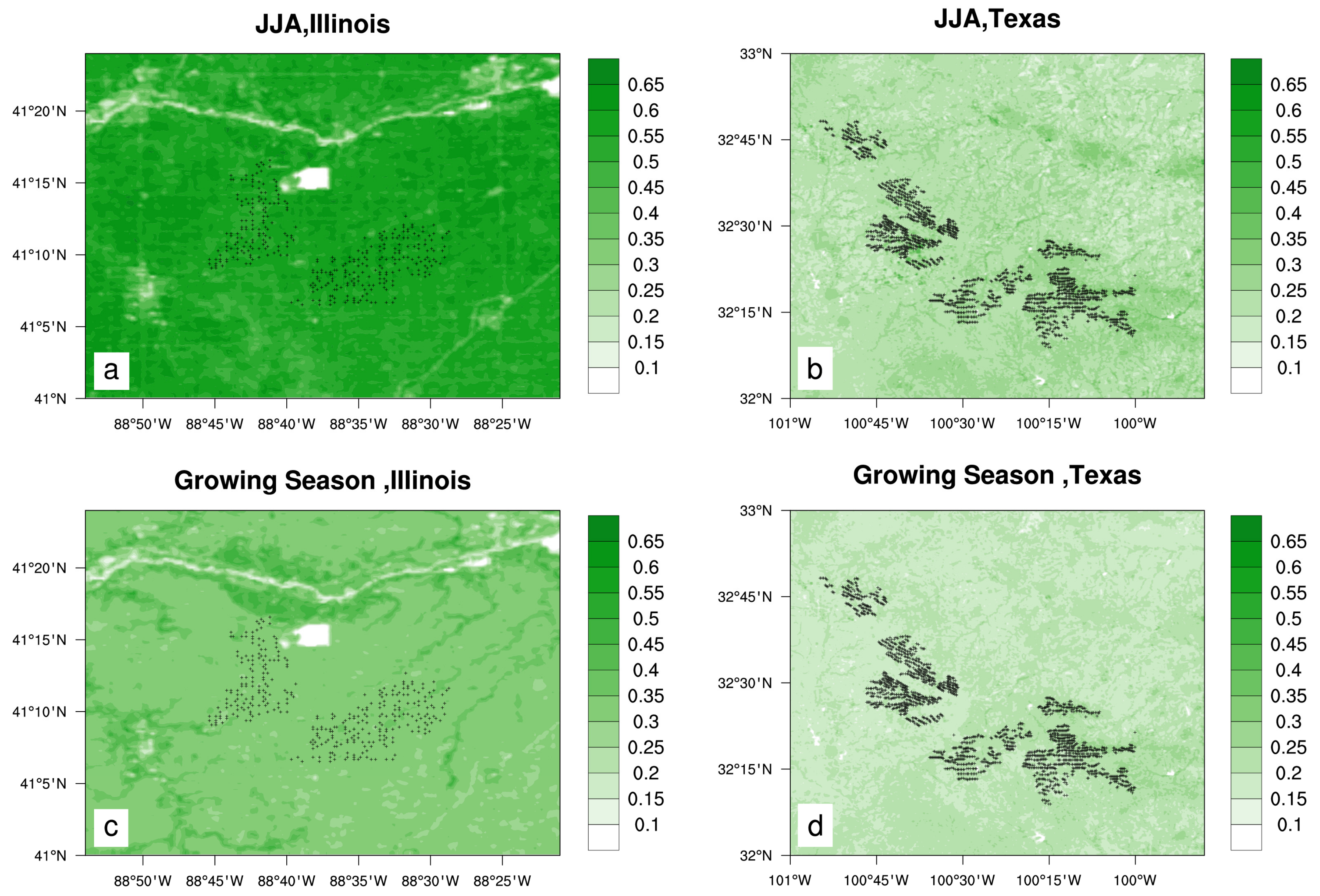
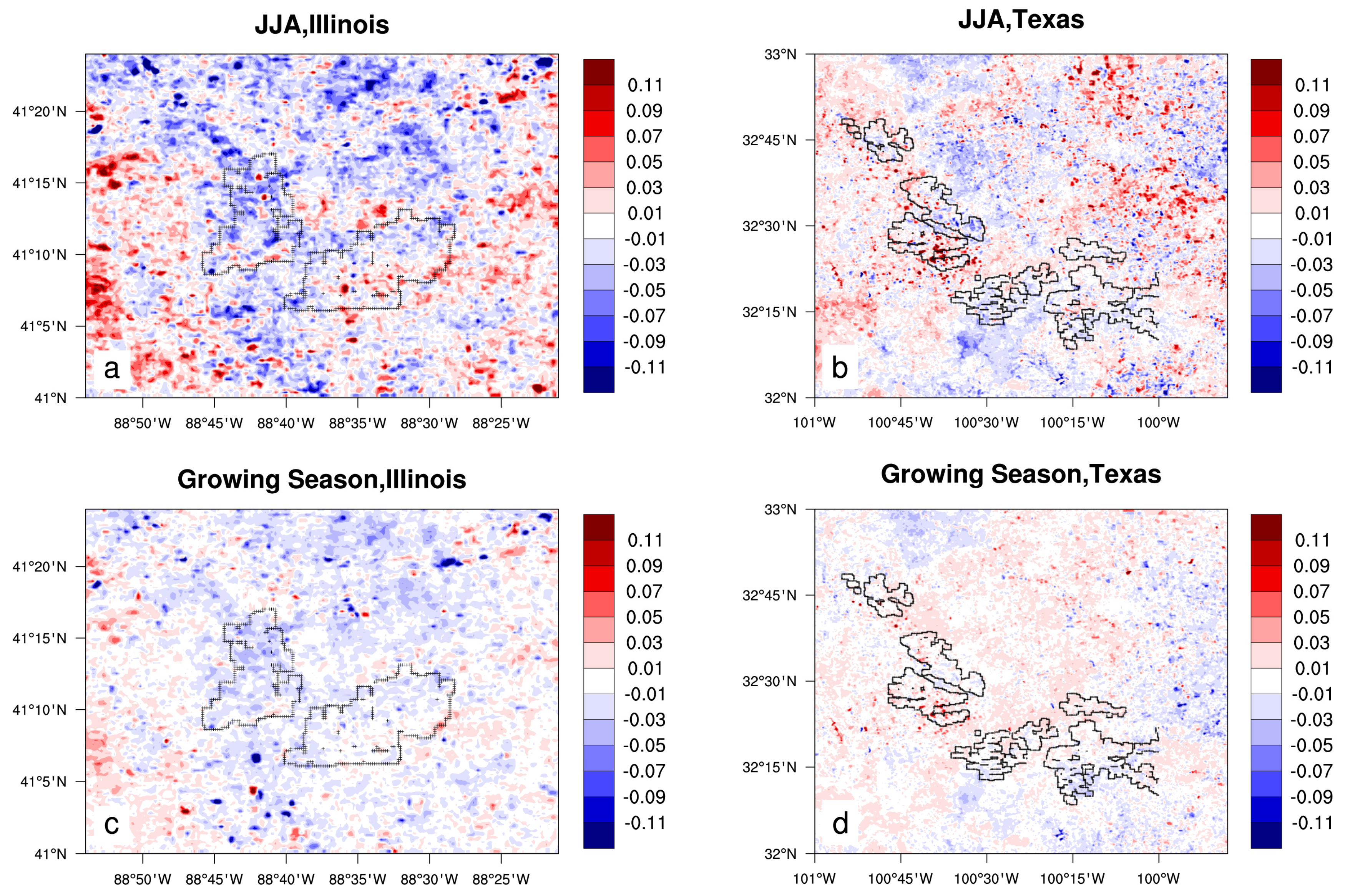


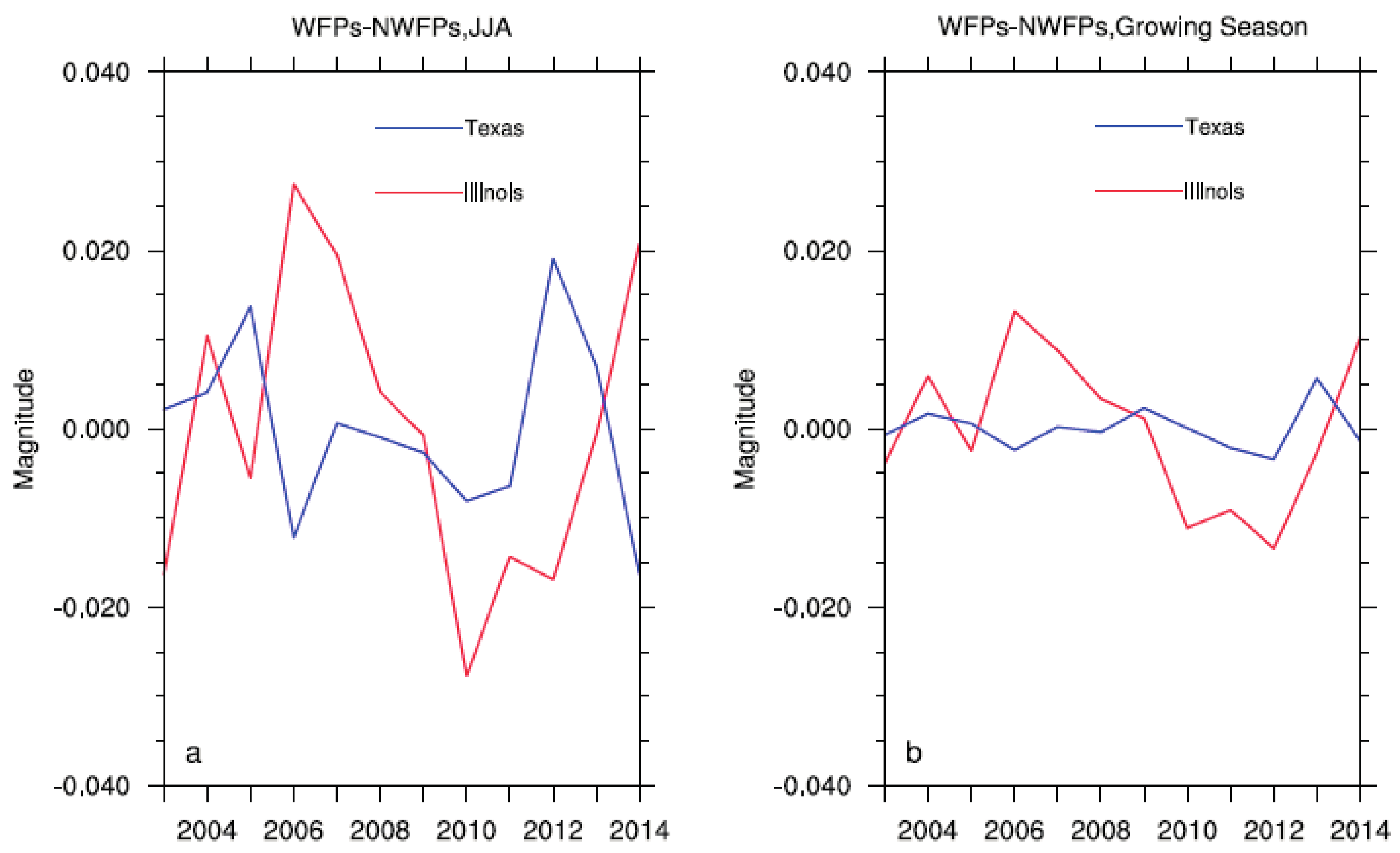
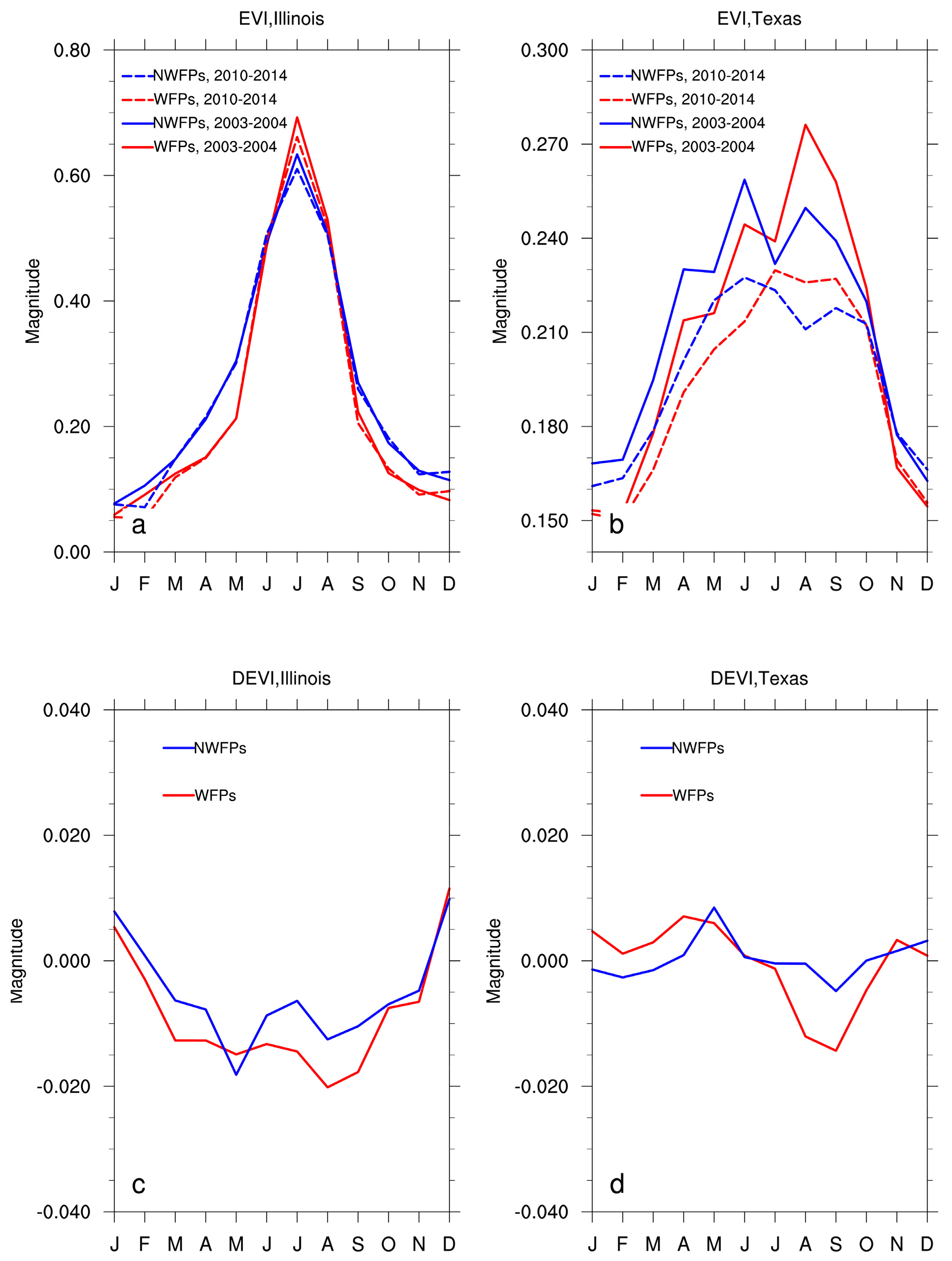
| Post-Turbine (2010–2014) Minus Pre-Turbine (2003–2004) | ||
| Illinois | Texas | |
| WFPs | −0.016 (−0.014) | −0.004 (<−0.001) |
| NWFPs | −0.010 (−0.010) | <−0.001 (0.001) |
| Post-Turbine (2011–2013) Minus Pre-Turbine (2003–2005) | ||
| Illinois | Texas | |
| WFPs | −0.018 (−0.015) | −0.001 (<−0.001) |
| DNWFPs | −0.012 (−0.010) | −0.001 (<−0.002) |
| Post-Turbine (2010–2012) Minus Pre-Turbine (2004–2005) | ||
| Illinois | Texas | |
| WFPs | −0.050 (−0.027) | −0.006 (−0.003) |
| DNWFPs | −0.023 (−0.013) | 0.001 (<0.001) |
© 2017 by the authors. Licensee MDPI, Basel, Switzerland. This article is an open access article distributed under the terms and conditions of the Creative Commons Attribution (CC BY) license (http://creativecommons.org/licenses/by/4.0/).
Share and Cite
Xia, G.; Zhou, L. Detecting Wind Farm Impacts on Local Vegetation Growth in Texas and Illinois Using MODIS Vegetation Greenness Measurements. Remote Sens. 2017, 9, 698. https://doi.org/10.3390/rs9070698
Xia G, Zhou L. Detecting Wind Farm Impacts on Local Vegetation Growth in Texas and Illinois Using MODIS Vegetation Greenness Measurements. Remote Sensing. 2017; 9(7):698. https://doi.org/10.3390/rs9070698
Chicago/Turabian StyleXia, Geng, and Liming Zhou. 2017. "Detecting Wind Farm Impacts on Local Vegetation Growth in Texas and Illinois Using MODIS Vegetation Greenness Measurements" Remote Sensing 9, no. 7: 698. https://doi.org/10.3390/rs9070698




